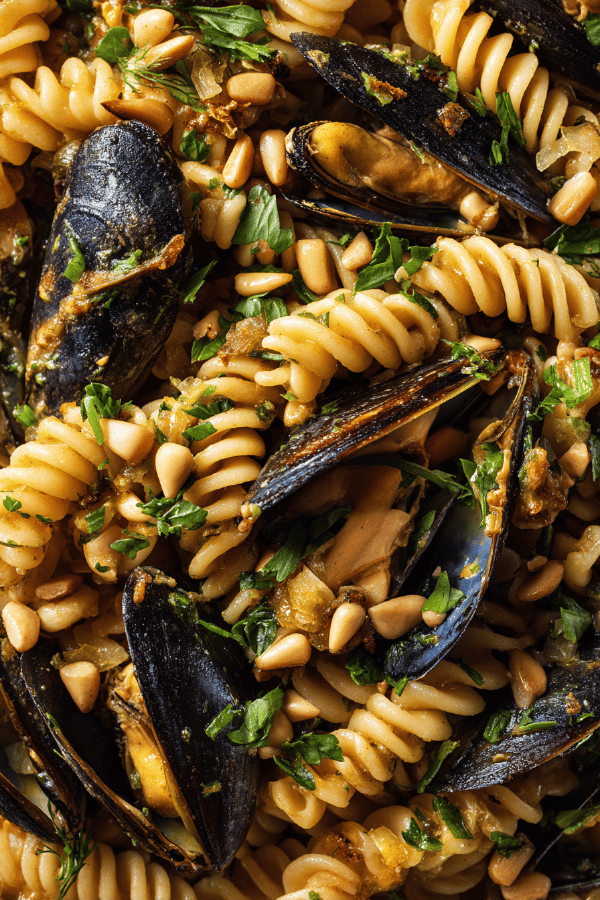Featured Recipe
Curried Mussels Fusilli

By Kate
"
Pasta tossed with smoky grilled mussels in a spiced coconut-curry sauce. Fusilli cooked al dente then combined with a reduction of white wine and mussel broth enriched with coconut milk. Shallots and garlic give a fragrant base while fresh tarragon replaces chives for a slightly anise note. Curry powder swapped for garam masala adds earthier complexity. A squeeze of lemon and sprinkle of toasted pine nuts finish the dish, adding brightness and crunch. Practical, adaptable for stovetop or grill leftover mussels. A balance of creamy, briny, and pungent flavors that hinge on timing pasta to sauce absorption and sauce reduction thickness.
"
Prep:
18 min
Cook:
22 min
Total:
40 min
Serves:
4 servings
mussels
pasta
seafood
coconut milk
garam masala
Introduction
Mussels whisper smoky notes from the embers, a leftover from last night’s barbecue that saves time today. Fusilli, spiral cut nests that catch sauce well. You want a sauce that’s creamy, but not dull - coconut milk folded with savory shellfish liquor, brightened by white wine and nuanced with dry garam masala instead of ordinary curry powder. Tarragon stands in, lending its aromatic licorice twist, fresh and assertive without overpowering. Pine nuts add crunch, a contrast to the chewy bite of mussels and pasta. Timing is everything here: the sauce must reduce just enough to glaze pasta, mussels warmed through but tender, without falling apart. Don’t cook ahead; remnants aren’t the same reheated. The fragrance of garlic, shallots, and spice fills the kitchen as the sauce thickens, coaxing a sheen on each noodle. Work fast once the mussels hit the pot; they lose tenderness with overheat. This isn’t fuss, it’s control — and knowing how to pull off complexity with few steps. Practical, bold, and satisfying.
Ingredients
About the ingredients
Quantity changes here play a critical role. Pasta bumped up slightly to 400g to prove more generous portions. Garam masala replaces curry powder for a deeper, earthier spice profile, important to not overpower delicate mussel flavor. Increase of olive oil supports sautéing shallots without burning. Mussel liquor and coconut milk slightly raised in volume for sauce balance after reduced flourish. Tarragon chosen over chives for flavor complexity; fresh herbs in small addition lift, don’t fight. Pine nuts introduced instead of chopped chives — an unexpected textural contrast, lending roast sweetness and crunch to the finish. Lemon juice sharpens and cuts through richness. Substitutions covered: no pine nuts? Use toasted almonds or no nuts at all but hold on freshness and acid. Fresh steamed mussels instead of grilled — retain cooking water to keep that muscular brine punch.
Method
Technique Tips
Step order restructured for practical flow and maximum flavor extraction. Start with pasta so it cooks while sauce bases are prepared in one pot - no extra pans, less washing. Use same pot to sweat aromatics post pasta boil to build fond layer on bottom, imperative for deep flavors. Garlic and shallots must soften gently, color pale gold not brown, to avoid bitterness. Stir in garam masala quickly to release oils but don’t scorch. Deglazing with wine is methodical — slow reduction with visible evaporation ‘film’ on surface is key, signals proper thickness and concentration. Coconut milk blended in with mussel liquor creates a luxurious, silky texture; boil into reduction rather than stew. Adding pasta and mussels late avoids overcooking; noodles finish absorb sauce gradually like a sponge, indicating readiness when coated fully and liquid reduced to a glossy sheen. Final seasoning with lemon juice balances fat, tarragon adds herby freshness. Pine nuts toasty, added last minute to remain crisp. Troubleshooting included: thin sauce means longer simmer or adding reserved pasta water carefully; too thick, dilute in spot. No rinsing pasta avoids sauce sliding off noodles, essential tip often ignored. Efficient, practical, adaptable technique proven in a working kitchen.
Chef's Notes
- 💡 Fresh mussels? Steam them instead. Retain cooking broth. Adds depth. If no fresh, canned mussels work too, but flavor varies, less texture.
- 💡 Want a thicker sauce? Don't be shy simmer longer. Watch it! Stir often; avoid burning. Too thin? Add reserved pasta water or let it reduce.
- 💡 Pine nuts not handy? Use toasted almonds or skip the crunch. Adjust. Flavor still fresh with lemon juice, tarragon retains herb kick.
- 💡 Check for doneness: pasta must cling to sauce, not watery finish. Toss gently, let it absorb. Stir, but avoid breaking mussels.
- 💡 Mussels toughen fast if overheated, timing is crucial. Heat just enough, to warm through at end. Gentle with the heat for best results.
Kitchen Wisdom
Can I use frozen mussels?
Yes, thaw them first. They can be convenient. Taste might differ slightly. Use same amount if drained.
Can I substitute coconut milk?
Almond or soy milk works, but adjust seasoning. Coconut adds richness, other milks less creamy.
How to store leftovers?
Refrigerate up to two days. Reheat gently. Not same. Avoid microwaving long - toughens mussels.
What if I overcooked pasta?
If mushy, it's done. Adjust cooking time for leftovers. Add less pasta next time maybe.



